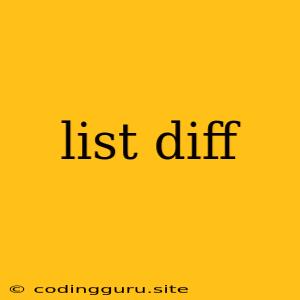Understanding List Diffs: A Guide to Identifying Changes in Lists
Have you ever worked with lists of data and needed to know exactly what changed between two versions? This is where the concept of "list diffs" comes in handy. A list diff, short for "list difference," is a way to highlight the modifications made to a list, making it easy to pinpoint the changes.
Let's dive deeper into the world of list diffs and explore how they can be beneficial in various scenarios.
Why are List Diffs Important?
List diffs are essential in numerous applications. Here's why:
- Version Control: When working with code, configurations, or data sets, tracking changes is crucial. List diffs provide a clear and concise representation of what has been added, removed, or modified in a list.
- Data Analysis: Understanding the differences between datasets can be crucial in data analysis tasks. List diffs help visualize the changes, making it easier to draw insights and understand trends.
- Software Development: When working with codebases, list diffs can highlight changes made to arrays or lists, making it easier to understand the impact of code modifications.
- Network Monitoring: List diffs are valuable in network monitoring tools to show the differences in network traffic patterns between two points in time.
How to Calculate List Diffs
The core concept of list diffs involves identifying the elements that are present in one list but not in the other. Here are common approaches:
1. Element-by-Element Comparison:
- This involves comparing each element in the two lists, one by one.
- If an element exists in one list but not the other, it's considered a change.
- This method is simple but can be inefficient for large lists.
2. Using Algorithms for Efficient Comparison:
- Several efficient algorithms are designed specifically for calculating list diffs. These algorithms use techniques like diffing algorithms (like the Myers diff algorithm) to identify the smallest set of changes required to transform one list into another.
- Libraries and tools often implement these algorithms, making the diffing process more efficient.
3. Utilizing Diffing Tools:
- Several tools are available that specifically handle list diffs. These tools provide visual representations of the differences, making it easy to understand the changes.
- Popular tools include:
- Git: A version control system that effectively displays list diffs when comparing different commits.
- Diff utilities: Tools like
diffin Linux/Unix systems offer various options for comparing files, including lists. - Online diff tools: Websites and web applications designed to compare text files and highlight changes, which can also be applied to lists.
Example: Visualizing List Diffs
Let's consider two lists, list1 and list2:
list1 = ['apple', 'banana', 'cherry']
list2 = ['banana', 'cherry', 'date']
A list diff tool would present the changes as follows:
--- a/list1
+++ b/list2
@@ -1,3 +1,3 @@
-apple
banana
cherry
+date
This diff shows that:
applewas removed fromlist1.datewas added tolist2.
Tips for Working with List Diffs
- Choose the Right Tool: Select a tool that aligns with your needs and offers the features you require.
- Understand the Output: Familiarize yourself with the format in which the list diff is presented, as different tools might use varying notations.
- Use Filtering Options: If working with large lists, leverage filtering options to narrow down the differences to specific elements of interest.
- Merge Changes Carefully: When merging changes from list diffs, ensure you understand the context of each modification before applying it.
Conclusion
Understanding list diffs is essential for working with lists, especially when tracking changes, analyzing data, and managing software development. The right tools and techniques can streamline the process of identifying and analyzing list modifications. By employing these methods, you can efficiently manage changes, make informed decisions, and work effectively with evolving lists of data.
